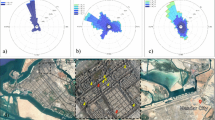Abstract
In the first part of this study, results of a computational fluid dynamics simulation over an array of cubes have been validated against a set of wind-tunnel measurements. In Part II, such numerical results are used to investigate spatially-averaged properties of the flow and passive tracer dispersion that are of interest for high resolution urban mesoscale modelling (e.g. non resolved obstacle approaches). The results show that vertical profiles of mean horizontal wind are linear within the canopy and logarithmic above. The drag coefficient, derived from the numerical results using the classical formula for the drag force, is height dependent (it decreases with height). However, a modification of the formula is proposed (accounting for subgrid velocity scales) that makes the drag coefficient constant with height. Results also show that the dispersive fluxes are similar in magnitude to the turbulent fluxes, and that they play a very important role within the canopy. Vertical profiles of turbulent length scales (to be used in k–l closure schemes, where k is the turbulent kinetic energy and l a turbulent length scale) are also derived. Finally the distribution of the values around the mean over the reference volumes are analysed for wind and tracer concentrations.
Similar content being viewed by others
References
Bougeault P, Lacarrere P (1989) Parameterization of orography-Induced turbulence in a mesobeta-scale model. Mon Wea Rev 117:1872–1890
Brown M, Williams M (1998) An urban canopy parameterisation for mesoscale meteorological models. AMS 2nd Urban Environment Symposium, Albuquerque, NM
Cheng H, Castro IP (2002) Near wall flow over urban-like roughness. Boundary-Layer Meteorol 104:229–259
Cheng Y, Lien FS, Yee E, Sinclair R (2003) A comparison of large Eddy simulations with a standard k − ɛ Reynolds-averaged Navier-Stokes model for the prediction of a fully developed turbulent flow over a matrix of cubes. J Wind Eng Indust Aero 91:1301–1328
Cionco RM (1972) Intentsity of turbulence within canopies with simple and complex roughness elements. Boundary-Layer Meteorol 2:435–465
Coceal O, Belcher SE (2004) A canopy model of mean winds through urban areas. Quart J Roy Meteorol Soc 130:1349–1372
Dupont S, Otte TL, Ching JKS (2004) Simulation of meteorological fields within and above urban and rural canopies with a mesoscale model. Boundary-Layer Meteorol 113:111–158
Finnigan J (2000) Turbulence in plant canopies. Annu Rev Fluid Mech 32:519–571
Galmarini S, Thunis P (1999) On the validity of Reynolds assumptions for running-mean filters in the absence of a spectral gap. J Atmos Sci 56:1785–1796
Kusaka H, Kondo H, Kikegawa Y, Kimura F (2001) A simple single-layer urban canopy model for atmospheric models: Comparison with multi-layer and slab models. Boundary-Layer Meteorol 101(3):329–358
Lien FS, Yee E (2004) Numerical modelling of the turbulent flow developing within and over a 3-D building array, part I: a high-resolution Reynolds-averaged Navier Stokes approach. Boundary-Layer Meteorol 112:427–466
Lien FS, Yee E, Wilson JD (2005) Numerical modelling of the turbulent flow developing within and over a 3-D building array, part II: a mathematical foundation for a distributed drag force approach. Boundary-Layer Meteorol 114:243–283
Macdonald RW, Hall DJ, Walker S (1998) Wind tunnel measurements of wind speed within simulated urban arrays. BRE Client Report CR 243/98, Building Research Establishment
Macdonald RW (2000) Modelling the mean velocity profile in the urban canopy layer. Boundary-Layer Meteorol 97:25–45
Martilli A, Clappier A, Rotach MW (2002) An urban surface exchange parameterization for mesoscale models. Boundary-Layer Meteorol 104:261–304
Pielke RA (1984) Mesoscale meteorological modeling. Academic Press, San Diego, CA, 612 pp
Raupach MR, Shaw RH (1982) Averaging procedures for flow within vegetation canopies. Boundary-Layer Meteorol 22:79–90
Santiago JL, Martilli A, Martin F (2007) CFD simulation of airflow over a regular array of cubes. Part I: 3-D simulation of the flow and validation with wind tunnel data. Boundary-Layer Meteorol 122 (in press)
Uno I, Ueda H, Wakamatsu S (1989) Numerical modelling of the nocturnal urban boundary layer. Boundary-Layer Meteorol 49:77–98
Author information
Authors and Affiliations
Corresponding author
Rights and permissions
About this article
Cite this article
Martilli, A., Santiago, J.L. CFD simulation of airflow over a regular array of cubes. Part II: analysis of spatial average properties. Boundary-Layer Meteorol 122, 635–654 (2007). https://doi.org/10.1007/s10546-006-9124-y
Received:
Accepted:
Published:
Issue Date:
DOI: https://doi.org/10.1007/s10546-006-9124-y




